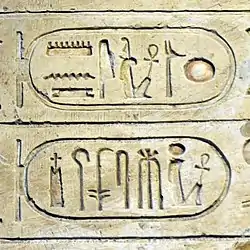Anthroponymy
Anthroponymy (also anthroponymics or anthroponomastics, from Ancient Greek ἄνθρωπος anthrōpos / 'human', and ὄνομα onoma / 'name') is the study of anthroponyms, the proper names of human beings, both individual and collective.[1] Anthroponymy is a branch of onomastics.
| Part of a series on |
| Linguistics |
|---|
|
|
Researchers in the field of anthroponymy are called anthroponymists. Since the study of anthroponyms is also relevant for several other disciplines within social sciences and humanities, experts from those disciplines also take part in anthroponymic studies, including researchers from the fields of anthropology,[2] history,[3] human geography,[4] sociology, prosopography,[5] and genealogy.
Anthroponymy of individual and family names

Anthroponymy of individual and family names, and their mutual correlations, includes the study of:
Anthroponyms of individuals can also be classified according to gender. Names of human males are called andronyms (from Ancient Greek ἀνήρ / man, and ὄνομα / name),[6] while names of human females are called gynonyms (from Ancient Greek γυνή / woman, and ὄνομα / name).[7]
Anthroponymy of group and population names
Anthroponymy of group and population names includes the study of demonyms (names of localized populations),[8] ethnonyms (names of ethnic groups),[9] as well as tribal names and clan names.
Related terms and processes
There are several specific terms and processes related to anthroponymy, like:
- anthroponymization, a process when an anthroponym is formed from an apellative, like when a surname is created from the name of ones occupation, thus forming an occupational surname. Such surnames are common in most languages, including English: Smith (from smith), Miller (from miller), Thatcher (from thatcher), Shepherd (from shepherd), or Potter (from potter).[10]
- deanthroponymization, a process when an anthroponym becomes an apellative, like when the surname of the inventor Louis Braille was used to create a name for the writing system for the visually impaired persons (braille).[11]
- transonymization of anthroponyms into toponyms, a process when a human proper name is used to form a toponym (proper name of a locality; place name), thus creating an anthropotoponym, like when the name of Alexander the Great was used to create several astionyms (city names), including name for the newly created city of Alexandria in the ancient Hellenistic Egypt, or when the surname of Christopher Columbus was used to create several choronyms (region names), including names for Southamerican state of Colombia, and Canadian province of British Columbia.[12]
- transonymization of toponyms into anthroponyms, a process when toponyms (place names) are used to form human names (anthroponyms), thus creating various topoanthroponyms.[13] Many surnames are created in that way, and they are known as toponymic surnames. Most demonyms (names for localized populations) are topoanthroponyms by formation, since they are usually created from toponyms, and also some ethnonyms are topoanthroponyms too (those that are formed from toponyms, and thus referred to as topoethnonyms).[14] For example, geographic designations for the region of Black Mountain (Montenegro) and frontier region of Ukraina (Ukraine) were used to create not only demonyms for general populations for those regions, but also ethnonyms for modern ethnic Montenegrins and ethnic Ukrainians.[15]
See also
| Look up anthroponymy in Wiktionary, the free dictionary. |
References
- Room 1996, p. 8.
- Bruck & Bodenhorn 2009.
- Ziolkowska 2011, p. 383–398.
- Bourin & Martínez Sopena 2010.
- Fossier 2010, p. 34.
- Room 1996, p. 6.
- Barolini 2005, p. 91, 98.
- Roberts 2017, p. 205-220.
- Room 1996, p. 38-39.
- Room 1996, p. 9.
- Room 1996, p. 28.
- Room 1996, p. 30.
- Gary Lefman (2013): Internationalisation of People Names
- Reis 2013, p. 58–61.
- Danver 2015, p. 348-349, 384-387.
Sources
- Barolini, Teodolinda, ed. (2005). Medieval Constructions in Gender And Identity: Essays in Honor of Joan M. Ferrante. Tempe: Arizona Center for Medieval and Renaissance Studies.
- Bourin, Monique; Martínez Sopena, Pascual, eds. (2010). Anthroponymie et migrations dans la chrétienté médiévale [Anthroponymy and Migrations in Medieval Christianity]. Madrid: Casa de Velázquez.
- Bruck, Gabriele vom; Bodenhorn, Barbara, eds. (2009) [2006]. An Anthropology of Names and Naming (2nd ed.). Cambridge: Cambridge University Press.
- Danver, Steven L., ed. (2015). Native Peoples of the World: An Encyclopedia of Groups, Cultures and Contemporary Issues. London and New York: Routledge.
- Fossier, Robert (2010). The Axe and the Oath: Ordinary Life in the Middle Ages. Princeton, NJ: Princeton University Press.
- Fraser, Peter M. (2000). "Ethnics as Personal Names". Greek Personal Names: Their Value as Evidence (PDF). Oxford: Oxford University Press. pp. 149–157.
- Reis, Levilson C. (2013). "The medieval forms and meanings of Francois: The political and cultural vicissitudes of an ethnonym". French Studies Bulletin. 34 (3): 58–61.
- Roberts, Michael (2017). "The Semantics of Demonyms in English". The Semantics of Nouns. Oxford: Oxford University Press. pp. 205–220.
- Room, Adrian (1996). An Alphabetical Guide to the Language of Name Studies. Lanham and London: The Scarecrow Press.
- Ziolkowska, Magdalena (2011). "Anthroponomy as an Element Identifying National Minority". Eesti ja Soome-ugri Keeleteaduse Ajakiri: Journal of Estonian and Finno-Ugric Linguistics. 2 (1): 383–398.